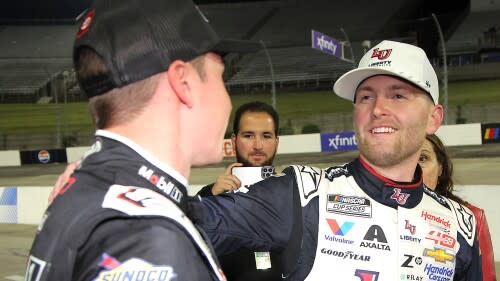It took nearly 30 minutes after the checkered flag for a Championship 4 field to emerge Sunday night at Martinsville Speedway.
The aftershocks from the tainted finish could last much longer.
As NASCAR officials work to untangle a convoluted and suspicious series of events that led to William Byron being awarded the fourth and final spot over Christopher Bell in the Nov. 10 title race season finale, there are many lingering questions about the actions of several drivers, teams and manufacturers at Martinsville.
The last time that NASCAR witnessed this level of potential race manipulation related to its playoffs, the fallout was massive and took years to unfold after the nefarious events of the regular-season finale held Sept. 7, 2013 at Richmond Raceway.
Long: Agonizing wait after Martinsville race leaves one NASCAR driver perplexed, another numb
NASCAR’s decision sends William Byron to title race, while Christopher Bell is eliminated.
Michael Waltrip Racing lost a sponsor and went out of business for good after the 2015 season. Martin Truex Jr. lost his playoff spot and later his ride. Jeff Gordon (who was part of Sunday’s postrace drama at Martinsville as Hendrick Motorsports’ vice chairman) gained a ticket to a championship format then known as “the Chase” – unilaterally added as the 13th driver by NASCAR chairman Brian France because of the extenuating circumstances.
There were three teams primarily involved in the Richmond scandal that infamously became widely known as “Spingate” – Waltrip’s team was hammered the hardest, but radio communications later emerged that cast aspersions on Front Row Motorsports and Team Penske.
There were at least five teams involved in the shenanigans Sunday night at Martinsville with two championship berths open and millions of dollars on the line.
Byron, who drives the No. 24 Chevrolet for Hendrick Motorsports, made the title round in part because Chevy drivers Ross Chastain of Trackhouse Racing and Austin Dillon of Richard Childress Racing stayed behind while running interference.
Byron’s No. 24 Chevrolet slipped to sixth –him one point ahead of Bell for the last Championship 4 spot – on Lap 486 of 500, leaving him directly ahead of Dillon in seventh and Chastain in eighth. Over the final 15 laps, Chastain and Dillon ran side by side behind Byron, swapping their positions four times while ensuring Byron remained sixth.
NBC’s postrace broadcast featured radio chatter from RCR and Trackhouse that made it clear the teams were orchestrating their drivers’ actions based on Byron’s position in the standings.
“I mean, that was disappointing to see them blocking like that and manipulating the race,” Bell told NBC Sports’ Dustin Long.
But questions also arose about how Bell initially made the Championship 4 field by making a last-lap pass of Bubba Wallace (which NASCAR later deemed illegal).
Wallace’s No. 23 Toyota slowed dramatically over the course of the last lap, trailing the pace of Bell’s No. 20 Toyota by more than 3 seconds. He radioed his 23XI Racing team about a possible flat tire and told reporters afterward that, “I went loose or something broke and was nursing it … just trying to bide our time and not crash and bring out a caution.”
NASCAR senior vice president of competition Elton Sawyer said only Bell’s wall-riding maneuver was considered during a lengthy postrace decision to dock the Joe Gibbs Racing driver four positions from 18th to 22nd (which put Byron in the championship round).
That leaves voluminous mountains of evidence to review – from cameras, computers and radios — starting today during the weekly race postmortem that can lead to NASCAR issuing penalties.
“We’ll look at everything,” Sawyer said. “We’ll take all the data, video. We’ll listen to in-car audio. We’ll do all that.”
NASCAR explains decision against Bell that sends Byron to championship race
NASCAR dropped Christopher Bell from 18th to 22nd for riding against the wall on the final lap at Martinsville.
Depending on the conclusions, the ramifications could be enormous. The rulebook affords NASCAR vast leeway in doling out penalties that can range from innocuous to draconian.
Could the punishment impact the Championship 4 field, perhaps by increasing – or even reducing — its size?
If that scenario seems unlikely, consider that it initially did after Richmond in September 2013, too – until earth-shattering developments unfolded daily that led to the Chase field being adjusted twice in five days.
Less than 48 hours after that race, NASCAR had kicked Truex out of the playoffs in favor of Ryan Newman. Four days after that, France added Gordon to the Chase – the day after the annual media availability for a 12-driver playoff field that had seemed permanently set.
Those rulings were rendered during another iteration of the playoffs (which switched to the current three-race elimination rounds the next year), and they were made with 10 races remaining in the season instead of one.
In this instance, it would be harder to announce a momentous and stunning call that would affect who races for the title.
But even if NASCAR refrains from action that impacts the Championship 4 this week, there could be a reckoning in the offseason.
Sunday night felt like NASCAR had reached a tipping point in how to determine its champion.
Brad Keselowski, who led a race-high 170 laps but finished ninth after getting stuck behind the Dillon-Chastain armada for the last 15 laps, said as much by posting “This should be the last straw on the camel’s back for the playoffs” on X immediately after the race (and while NASCAR still was reviewing the finish).
This is NASCAR’s 21st year with a playoff, and its current structure has been static for 11 seasons – an unusually long time without a full evaluation.
During its first 10 years, the Chase/playoffs were tweaked twice and overhauled once.
In the decade since, there have been an increasing number of examples in which the boundaries of racing ethics and morality are being pushed by massive stakes. It’s been particularly evident in the rising tide of manufacturer alliances impacting superspeedway races, which have become more prevalent with Atlanta joining Daytona and Talladega since 2022.
Martinsville, though, marked the first time that the subterfuge rose to the level of Richmond in 2013.
That’s why it could be an inflection point that NASCAR needs for a reassessment of its playoffs – and perhaps some significant changes.
EMEA Tribune is not involved in this news article, it is taken from our partners and or from the News Agencies. Copyright and Credit go to the News Agencies, email news@emeatribune.com Follow our WhatsApp verified Channel






